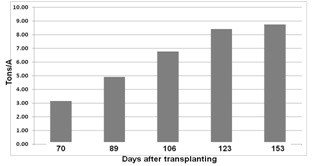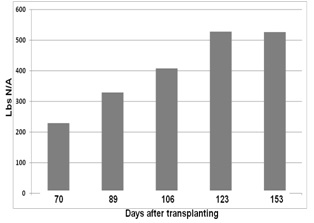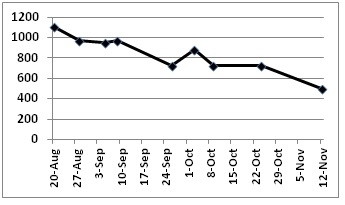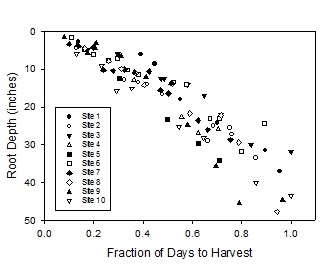Acreage of Brussels sprouts is expanding in Monterey County from the traditional production areas along the immediate coast in Castroville and Moss Landing to as far south as Chualar and Gonzales. Interest by growers in efficiently managing nitrogen (N) applications in Brussels sprout production prompted us to conduct evaluations of mineral nutrition and nitrogen uptake dynamics in 2013 and 2014. In 2013 we conducted a preliminary study of nutrient uptake of a well-managed field. Table 1 shows the results of the total nutrient uptake of Brussels sprouts. The data shows the distribution of the various nutrients in the plant. The highest concentration of N is in the sprout (5.13%) which is almost two times the concentration found in the leaves (2.66%). Phosphorus is also concentrated in the sprouts (0.66%) with a much lower concentration in the leaves (0.24%). Potassium concentration in the sprouts (4.10%) was about the same as in the leaves (3.98%). Potassium had the highest whole-plant concentration (3.85%) than other nutrient. Calcium concentration in Brussels sprout leaves was very high (3.23%), but was much lower in the sprouts (0.36%). The low concentration of calcium in the sprouts is due to the low transpirational flow of water in the inner tissue of the sprout, which may explain why Brussels sprouts can be quite susceptible to tipburn at times (Figure 1). Of the micronutrients, zinc and copper had greater concentrations in the sprouts while iron, manganese and boron were more concentrated in the leaves.
Evaluation of the crop biomass indicates that about 21% of the biomass was in the sprouts, 47% in leaves and 33% in stalks (Table 2). The total dry matter in the crop was 14,862 lbs/A. Potassium uptake by the crop was 593 lbs/A, followed by N uptake 490 lbs/A and calcium 267 lbs/A. The combination of high concentration of nutrient and high crop biomass resulted in nutrient uptake that exceeded values we have observed in other cole crops such as broccoli and cabbage, and may be the highest of any vegetable grown in the Salinas Valley.
Brussels sprout is a long-season crop which makes nutrient management a challenge; for the majority of the crop cycle, tractors cannot enter the field to make fertilizer applications. The question arises, how can growers supply sufficient N to this high demanding late in the growth cycle? Nitrogen can be injected into the irrigation system, but how much N is needed by this high N demanding crop. In 2014 we worked with a grower who observed strong growth of his Brussels sprouts in spite of low N applications to the field. He still had 4+ months until harvest and had questions about how much N to supply his crop over the remainder of the growing season. One difficulty is that we have limited information on petiole nitrate levels of Brussels sprouts over the course of the growing season. We chose his youngest block for evaluations of N uptake by Brussels sprout. The block was transplanted in mid-June and our evaluations started mid-August. Up to that point the grower had applied 71 lbs N fertilizer/A. We evaluated biomass and biomass N accumulation over the remainder of the growth cycle, as well as nitrate levels in petiole fresh sap and dry tissue. Fresh sap nitrate analyses were made with a Cardy nitrate meter and dry tissue petiole nitrate levels were determined at the UC Davis Analytical Lab. Figure 2 shows the accumulation of dry biomass and Figure 3 shows the biomass N accumulation over the growth cycle. It is interesting to note that the crop had already taken up over 200 lbs N/A by the first evaluation date, 70 days after transplanting. Nitrogen uptake continued at a steady rate of over 5.0 lbs N/A/day until 123 days after transplanting at which time the rate of N uptake slowed. The grower applied a total of 145 lbs N/A in five fertilizer applications and the obvious question is where did the remaining 380 lbs N in the crop came from.
Other sources for nitrogen that could have provided for this crop include:
- Nitrogen in the irrigation water
- Residual soil nitrate
- Nitrate mineralized from soil organic matter and prior crop residues over the crop cycle
- Nitrate deeper in the soil profile that the roots access over the crop cycle
The nitrate levels in the irrigation water were below 2.5 ppm NO3-N which would not contribute a significant amount of N. Soil nitrate down to three feet in the soil amounted to a total of 57 lbs N/A when monitoring began in August, but much of the 200+ pounds of N already in plant biomass at that time may have come from soil residual nitrate. We did not measure the rooting depth of the crop, but given that Brussels sprouts are in the ground for 150+ days, there is a strong possibility that the roots extend rather deep. We have measured broccoli roots down to 3 to 4 feet deep in 90 days (Figure 4). If we assume that Brussels sprout roots grow at the same rate as broccoli roots, they could extend down much deeper (e.g. 4 to 5 feet). This is an areas that needs more research in the coming year. Nitrate mineralization from soil organic matter could have been significant at this site. The soil was a Salinas clay loam which can potentially mineralize 1.0 to 1.5 lbs N/A/day. This amount of N could contribute (100 – 150 lbs N/A) over the crop cycle. It is clear that this crop can efficiently mine the soil for nitrogen and where substantial soil residual N is present, only a modest amount of N fertilizer is required.
Petiole fresh sap vs dry tissue nitrate values were moderately correlated (R2 = 0.71). Nitrate-N in the fresh sap of the petioles of Brussels sprouts followed a typical trend over the course of the growth cycle (Figure 5). They started at 1100 ppm nitrate-N when the buds on the plant were just beginning to form. They declined to 700 ppm nitrate-N over the course of sprout development and finished the crop cycle at 500 ppm nitrate-N. These values were similar to values that have been observed for broccoli. These preliminary data provide an indication of where Brussels sprout fresh sap petiole levels should be; our goal is to finalize these values to provide a diagnostic tool for growers to use to better manage N Brussels sprouts, a long-season, high-nitrogen demanding crop.

Table 1. 2013. Concentration of plant nutrient in Brussel sprout tissues and whole plant
| Plant tissue |
Nitrogen % |
Phosphorus % |
Potassium % |
Sulfur % |
Calcium % |
Magnesium % |
Boron ppm |
Zinc ppm |
Manganese ppm |
Iron ppm |
Copper ppm |
| Sprouts | 5.13 | 0.66 | 4.10 | 1.35 | 0.36 | 0.18 | 20.8 | 39.2 | 30.0 | 193.1 | 4.3 |
| Leaves | 2.66 | 0.24 | 3.98 | 1.43 | 3.23 | 0.42 | 47.4 | 21.9 | 87.6 | 557.0 | 1.7 |
| Stalks | 2.63 | 0.53 | 3.38 | 0.84 | 0.65 | 0.24 | 19.7 | 22.9 | 19.0 | 177.4 | 3.0 |
| Whole plant | 3.48 | 0.41 | 3.85 | 1.20 | 2.02 | 0.38 | 35.7 | 28.3 | 77.4 | 340.9 | 2.9 |
Table 2. 2013. Plant biomass and nutrient uptake
| Plant tissue |
Fresh weight lbs/A |
Percent of whole plant |
Dry weight lbs/A |
Nitrogen lbs/A |
Phosphorus lbs/A |
Potassium lbs/A |
Sulfur lbs/A |
Calcium lbs/A |
Magnesium lbs/A |
Boron lbs/A |
Zinc lbs/A |
Manganese lbs/A |
Iron lbs/A |
Copper lbs/A |
| Sprouts | 22,272 | 20.1 | 2,827.0 | 153.9 | 19.8 | 122.9 | 40.6 | 10.9 | 5.4 | 0.1 | 0.1 | 0.1 | 0.6 | 0.01 |
| Leaves | 52,026 | 47.0 | 6,393.8 | 179.5 | 16.1 | 269.2 | 97.2 | 218.0 | 28.4 | 0.3 | 0.1 | 0.6 | 3.9 | 0.01 |
| Stalks | 36,315 | 32.8 | 5,641.3 | 157.0 | 31.6 | 201.0 | 50.4 | 38.6 | 14.5 | 0.1 | 0.1 | 0.1 | 1.0 | 0.02 |
| Whole plant | 110,613 | --- | 14,862.1 | 490.3 | 67.4 | 593.2 | 188.2 | 267.4 | 48.3 | 0.5 | 0.4 | 0.8 | 5.5 | 0.04 |



